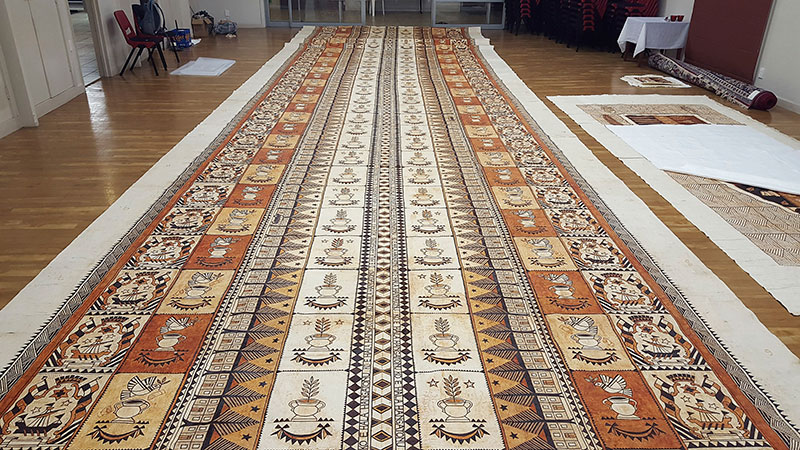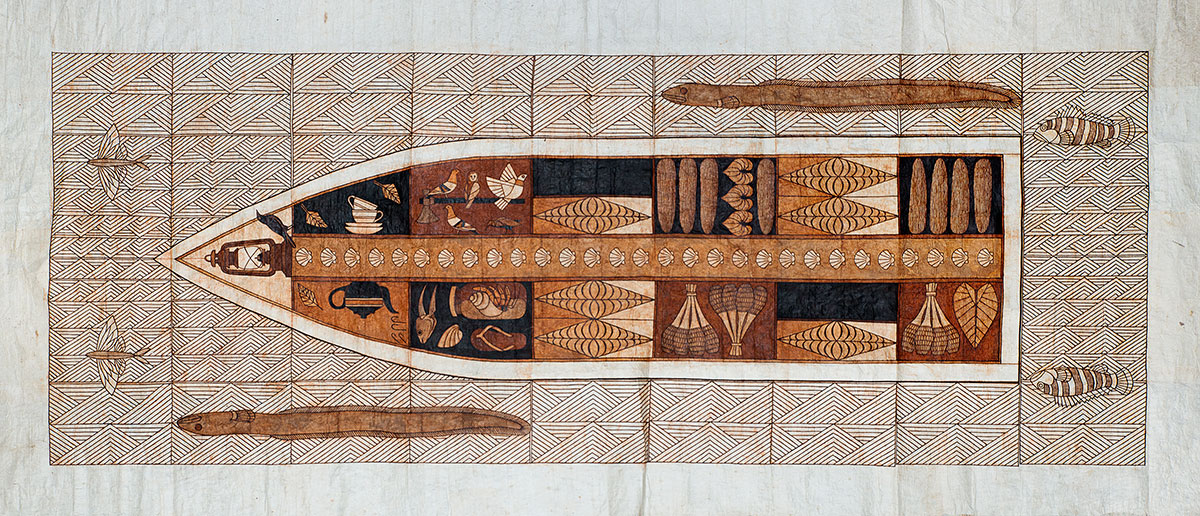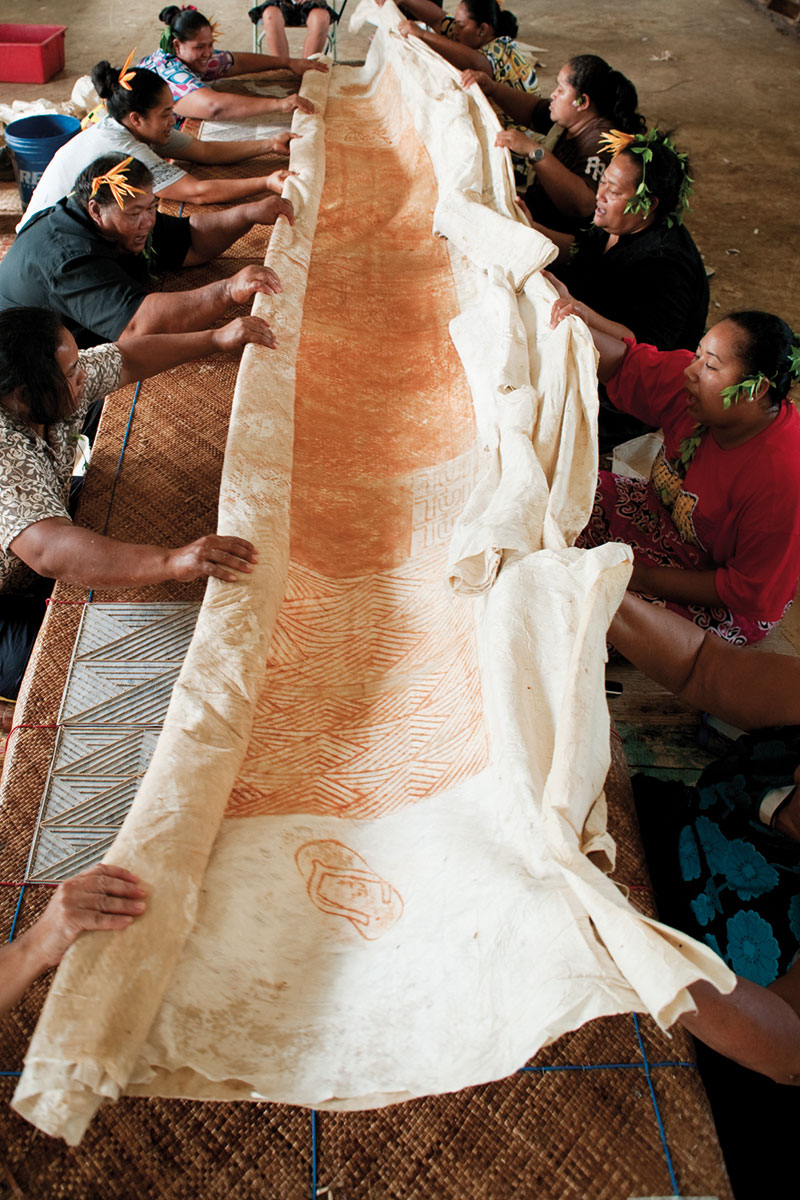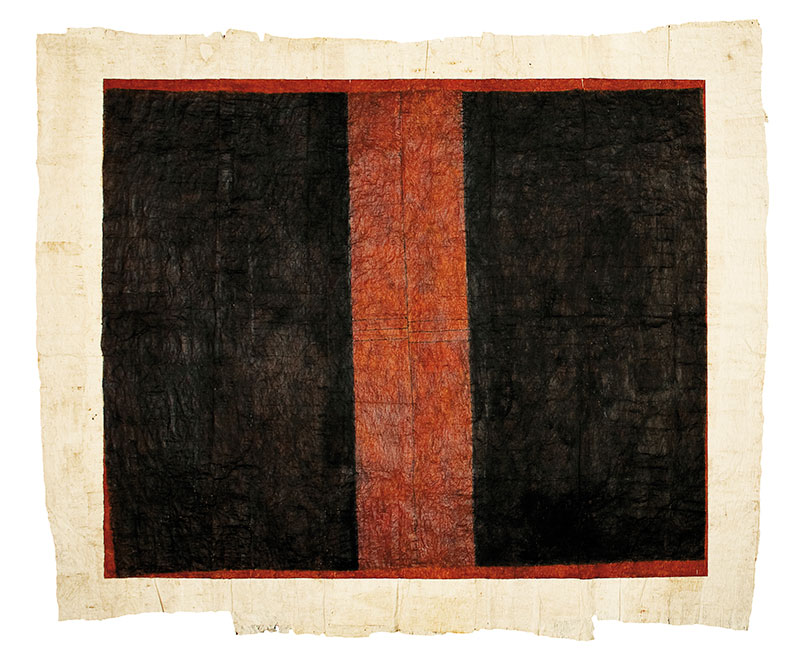
The sea is our pathway to each other and to everyone else, the sea is our endless saga, the sea is our most powerful metaphor, the ocean is in us.
- Epeli Hau'ofa, "The Ocean in us"[1]
According to Tongan visionary Epeli Hau‘ofa, the ocean is the foundation of Pacific regional identity, connecting all islanders. As a pathway of connection and being, Siu i Moana, by Robin White and Ruha Fifita, reaches across that ocean. Together with exhibitions of work by Greg Semu, Lisa Reihana, and a range of works from the National Gallery of Victoria’s permanent collection, these four exhibitions curated by Judith Ryan form the largest display of contemporary Pacific art to be shown in Australia outside of the Asia Pacific Triennial. Some of the most thoughtful and arresting work in the region is currently being produced by artists of Pacific Islander heritage, yet it has received little attention in Australia until now.
The choice of barkcloth (ngatu), commonly known as tapa, as a medium by White and Fifita reflects its continuing place in Tongan life. Referred to by White as “the DNA of the Pacific”, ngatu is created and used across Oceania to decorate, wrap, protect and carry the human body. As such, it is an integral item of gift and exchange in all important life events, especially in Tonga. Both followers of the Bahá’i faith, White and Ruha have imbued Tongan ngatu, with this spiritual dimension, building on its rich heritage. They address a number of issues in these vast pieces, but the works are unified by extraordinary attention to detail in both the cloth production and painting stages, highlighting traditional methods at every stage of the process.

Tongan ngatu is made from the inner bark of the paper mulberry tree, which is softened and expanded by a process of beating to produce thin sheets of paper skin. As explained by NGV curator Judith Ryan, “producing ngatu is a lengthy and multi-layered process undertaken communally by groups of women who, in beating, joining, pasting and rubbing small sections of the cloth over kupesi (patterned rubbing blocks) imbue the ngatu with layers of meaning, stories, sounds, textures and resonances". Brown dye brings out the pattern from the raised elements of rubbing blocks beneath and key motifs are heightened by hand-painting, which introduces linear and painterly elements and patterned and plain sections. An integral part of each ngatu composition is the white undyed border, which is deliberately left on two or more sides.
The works were created in collaboration with a women’s tapa group from Haveluloto in Tonga. Ruha’s sister Ebonie Fifita collaborated on three of the works; Keiko Ma‘asi from the tapa group contributed as well. This degree of collaboration is required to support connection but also highlights the sheer amount of work involved in producing such large-scale works.

The Siu I Moana exhibition comprises three discrete collaborative projects displayed together for the first time. Siu I Moana (2011), a triptych from which the exhibition takes its name, comprising two figurative and one black dyed ngatu; We are the small axe (2013), portraying links between Pacific cultures and alluding to the struggle of indigenous peoples against colonial rule; and Ko e Hala Hangatonu: The Straight Path (2013–16), which consists of four pieces, including one ngatu ta‘uli. Ngatu ta‘uli, the most difficult and time-consuming ngatu the Tongans produce, which “features a large black void formed by layers of soot derived from burning candlenut, a precious black pigment that signifies unknowability”.[2] A further two works in the exhibition, Rangitahua and The Crimson Sea, are examples of this rare form.

The series overall is a composition of eight striking works that celebrate community, connectedness across cultures, suffering and celebration, dark and light, and the centrality of the sea to life across the Pacific. Ko e Hala Hangatonu: The Straight Path (2013–16) series in particular extends the concept of a pathway out to include connections between East and West, past and present, the everyday and transcendental. The recently completed Seen Along The Avenue (2015–16), was inspired by the Tongan tapa design of the Road of Pines (Hala Paini) representing the road, fringed with Norfolk Pines, that leads from the King’s palace to the royal tombs. The avenue of the title refers to Ben Gurion Avenue in Haifa, Israel, which leads from the shores of the Mediterranean to the foot of Mount Carmel. In this ngatu, as Ryan states, “stylised motifs of crisis and victory, and life and death, represent alternating rhythms, patterns and vicissitudes of life.” Such rhythms are not all earnest. The previous king’s eccentric London taxi appears in one work; tins of corned beef feature in another. Hung from the wall and spread out across the floor, at a length of 25 metres, it dominates the space, and is by far the largest painting in the National Gallery of Victoria. As such, it goes beyond the exquisite construction and finish of this series, becoming a tribute to millennia of tapa making across the Pacific. For White and Fifita, the collaborative creative process of working with the earthly materiality, timbre and temporality of barkcloth and traditional dyes, engenders a sense of wholeness. The layers of soft white ngatu, painstakingly painted with metaphoric and symbolic designs, are envisioned by both artists as a spiritual wrapping, bringing people together, regardless of race and age, to bring hope and renewal to the entire community.[3]
Footnotes
- ^ Epeli Hau‘ofa, 2008. ‘The ocean in us’ in We Are the Ocean: Selected Works, University of Hawai’i Press: Honolulu, 2008, p. 59.
- ^ See https://www.ngv.vic.gov.au/essay/siu-i-moana-reaching-across-the-ocean/
- ^ From an interview between the authors, Robin White and Ruha Fifita, Melbourne, 12 June 2016.

